The earliest planting plans by the Olmsteds in 1916 preserved many large Douglas fir trees and included large drifts of spring bulbs. When current garden curators and landscape designers Glenn Withey and Charles Price joined the Dunn Garden, they immediately added an additional 5000 crocus bulbs to the sweeping lawns, and add several thousand every year. I thought they were even more impressive than the snowdrops; maybe next year they can call it the ‘Crocus Constitutional‘.
Don’t tell Glenn and Charles, but this guy snuck under the rope to get a closer look!
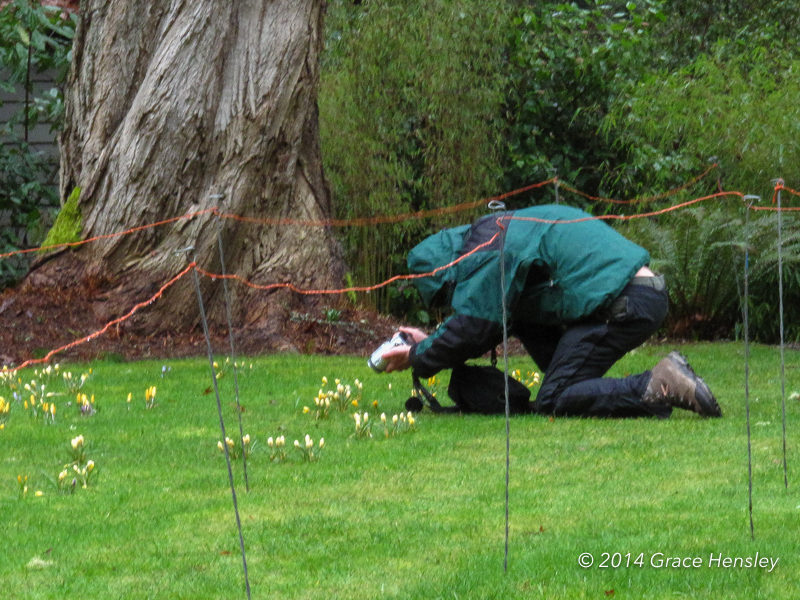
Crocus Identification
Writer E. A. Bowles, a keen gardener known for his descriptions of crocuses in ‘My Garden in Spring’, learned his botany well, and it came in good stead when asked the name of some autumn-flowering rosy-lilac flowers. Peering into them, he noted 6 stamens, and replied, “A Colchicum, but I am not sure which.” He passed the test, knowing that the Colchicum is in the Lily family, with 6 stamens, while the Crocus is in the Iris family and has only 3. Those three stamens are the same parts collected from Crocus sativus that we use in cooking as saffron. Peer into a crocus the next time and see if you can identify them.
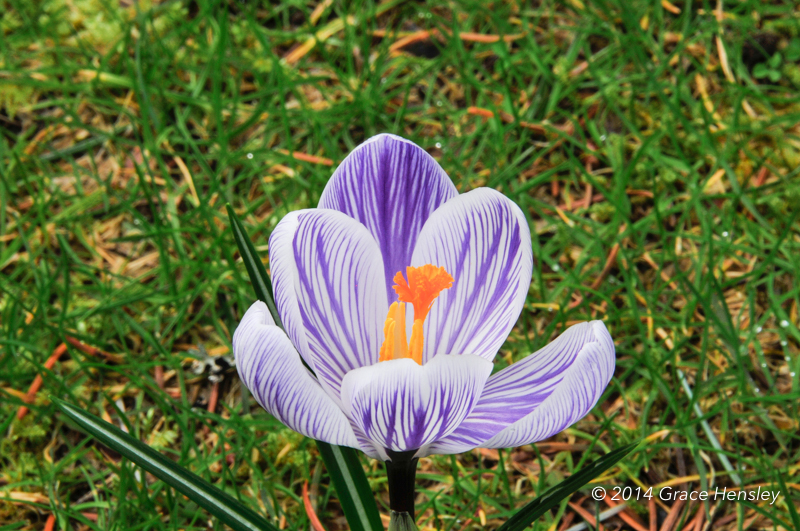
Early Crocuses
The best choice for lawns is the woodland species crocus, Crocus tomasinianus. Early flowering, some blooms were already starting to fade by the third week of February. Bowles named several selections of ‘tommies’ including C. tomasinianus ‘Bobbo’, which he chose “to remind me of the sharp-eyed boy who was the first to spot it”. It’s a lovely pale lavender tipped with white. I wish I’ld seen it first, but alas, I’m 100 years too late. You’re going to meet E.A. Bowles frequently, as many interesting plants are named in his honor, but we’ll save those for another post. The delicate flowers of C. tomasinianus, like dancing fairies, reach just above the lawn on their long necks, and the deep green leaves almost disappear into the twinkling dew.
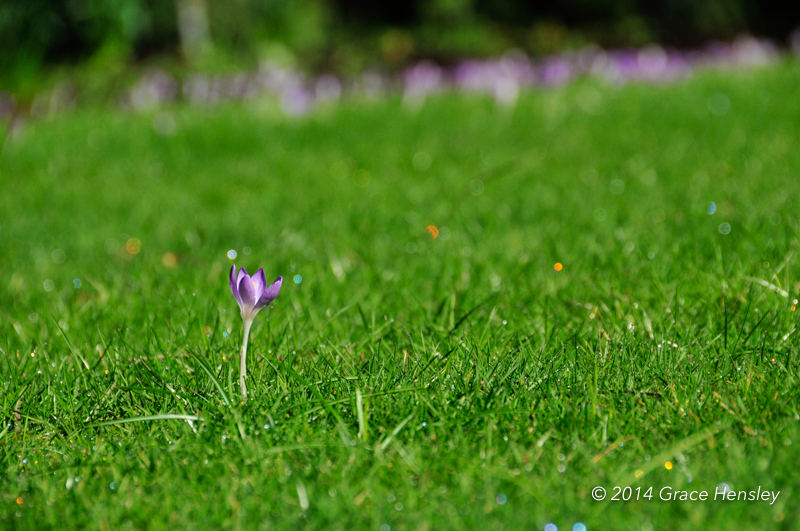
Withey and Price chose C. tomasinianus ‘Ruby Giant’, ‘Barr’s Purple’, ‘Whitewell Purple’, and ‘Roseus’ to put in the lower Great Lawn at the Dunn Gardens. They were fainting by the third week of February, but when I returned this week in early March, they were completely flat. Other worthy, but rare, selections to consider are Crocus tomasinianus f. albus, with lavender paint-flecks on pure white petals, and C. tomasinianus ‘Eric Smith’, which is easy to identify with its two extra petals.
Another early crocus is Crocus sieberi ssp. sublimis var. tricolor with its distinctive white band in the middle. It is known for its long bloom time and soft perfume. I think it wasn’t warm enough on the day I visited; you can see the flowers are tightly closed. Maybe I didn’t get my nose close enough, as I didn’t notice its scent.
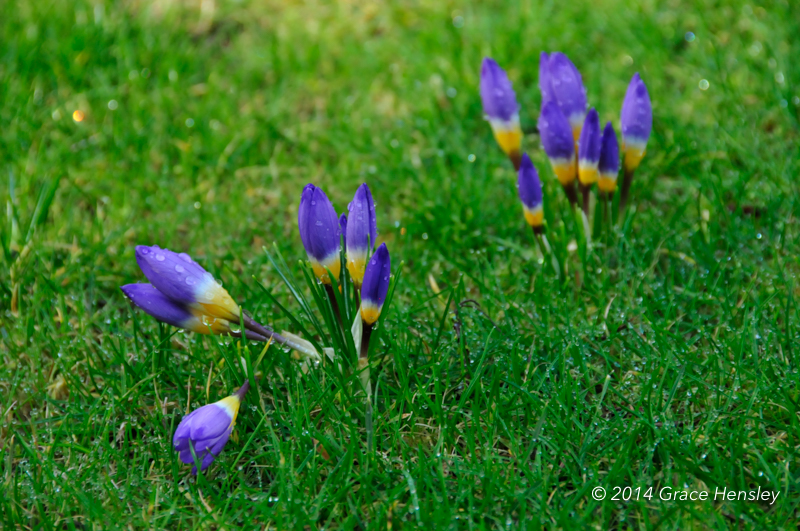
When I returned just two weeks later, the warmer afternoon sun had encouraged the flowers to open.
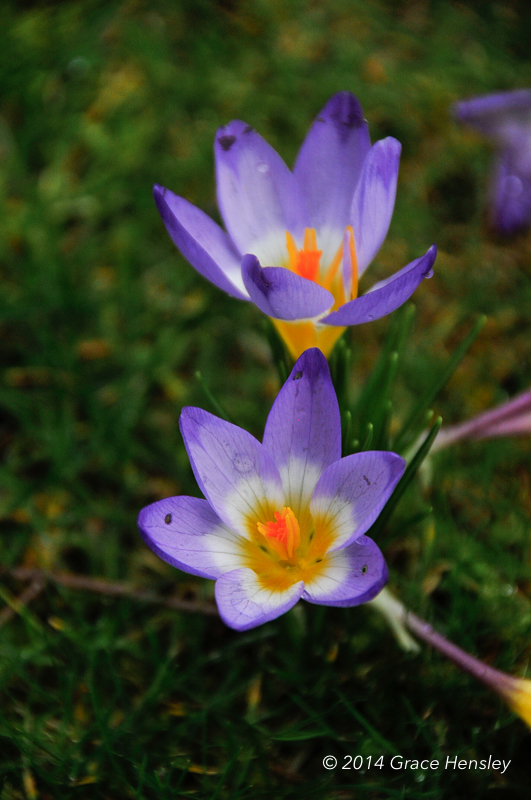
Ed’s Lawn
The upper lawn near the big house is affectionately known as Ed’s Lawn, named for the Dunn’s son Edward, an enthusiastic native gardener and rhododendron expert. Ambitiously, the Withey-Price team peeled back large sections of lawn and planted thousands of deep purple C. vernus ‘Remembrance’, the violet ‘Pickwick’ and the white ‘Jeanne d’Arc’.
“For show from a distance, or for viewing out a window, the vernus hybrids can’t be beat” remarked Price.
Large sweeps of bicolored C. vernus ‘Vanguard’ make an impressive vista. I didn’t know quite their impact until I visited on a warmer afternoon; the blooms almost breathed in and out with every passing cloud.
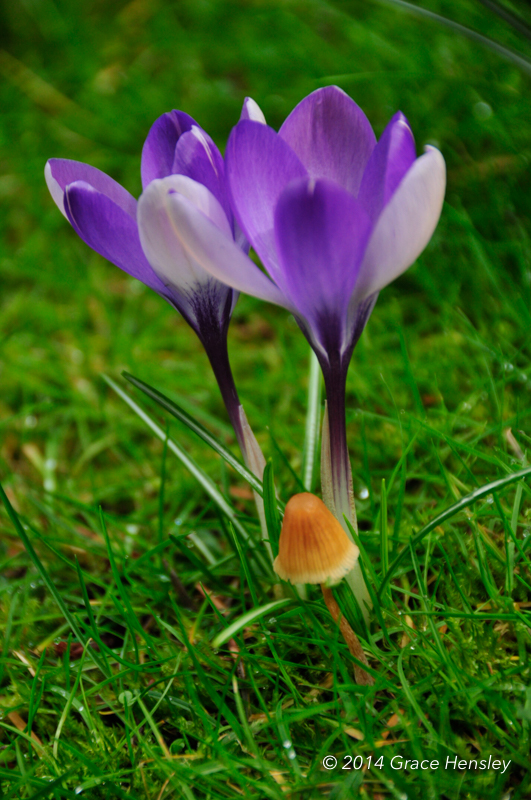
In addition to those varieties, Withey and Price included in the upper lawn,
- C. vernus ‘Yalta’ – possibly a hybrid between tommasinianus and x Cultorum, it shows the soft bicolor form of its parentage, but seems to show some pale striping.
- C. vernus ‘Flower Record’ – a solid medium purple with glossy edging
- C. vernus ‘King of the Striped’ – greyish-white flowers with dark purple stripes
- C. vernus ‘Twilight’ – an heirloom from 1910, with a deep indigo color
- C. vernus ‘Grand Maitre‘ – an heirloom from the 1920s, in pale lavender with a silvery sheen
- C. ancyrensis ‘Golden Bunch’ – an early blooming 1879 heirloom in a shocking tangerine yellow, several flowers per corm
- C. flavus ‘Golden Yellow’ – a fragrant golden-yellow crocus that blooms with C. vernus, several flowers per corm
- C. Chrysanthus ‘Blue Bird’ – a white crocus with dark purple on the outer petals.
- C. sieberi ‘Tricolor’ – pictured above, a distinctive white band separates the purple petals and the yellow throat.
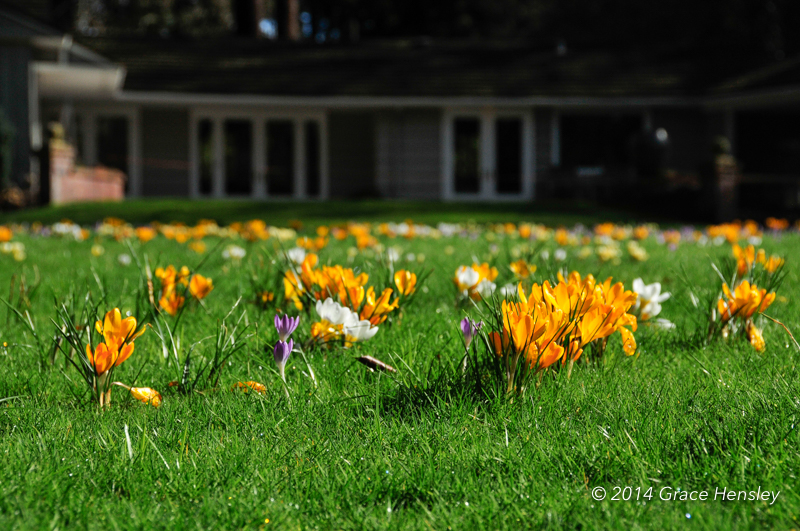
And in the lower Great Lawn, the yellows and whites “show up the best in the winter gloom,” remarked Price. He included:
- C. chrysanthus ‘Ard Schenk’ – delicate white blooms with a yellow throat
- C. chrysanthus ‘Cream Beauty’ – a pale buttery yellow with a deep yellow throat.
- C. chrysanthus ‘Romance’ – a creamy yellow
- C. chrysanthus ‘Goldilocks’ – a very early bloomer (with galanthus and before vernus). Dark yellow with a purplish-brown feathering on the outside.
- C. chrysanthus ‘Advance’ – Distinctly yellow petticoats and dark purple over-dress.
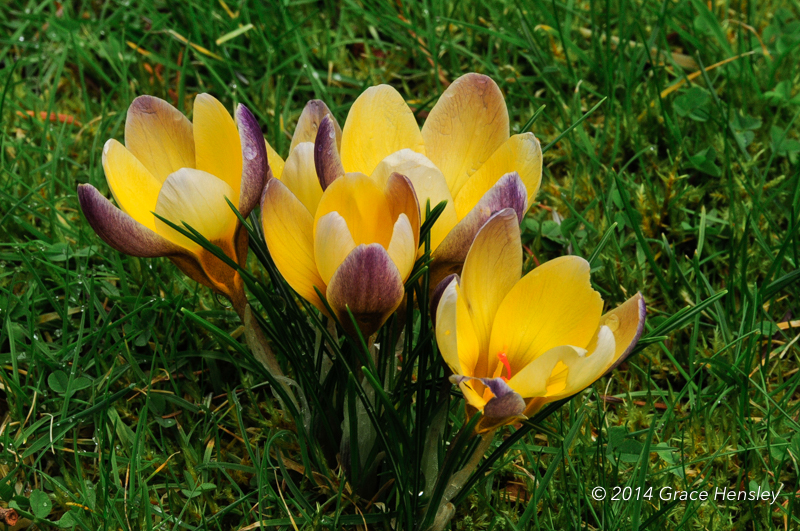

Planting your own lawn
If you want to establish a crocus lawn yourself, first grow some large Douglas firs. No, seriously, just choose a slightly-shaded, thin-lawned area. Crocuses do well in lean alpine soils with good drainage, and are fine if they bake a little over the summer, since they are native to Greece and Turkey.
Next, rejuvenate your turf. It’s the last time you’ll do it. Dethatch, aerate, and overseed any bare patches. Water well in summer. Give the lawn one last good haircut in mid-September and put away your lawn mower. Don’t take it out again until the 1st of May.
Then, buy a hundred bulbs (or a few thousand) and cast them randomly about your lawn. It’s up to you whether you put on fairy wings when you sprinkle them around; your neighbors aren’t usually up that early in the morning. Dig them in at least 5-6″ to keep the squirrels from finding them.
At the Dunn Gardens in 2007, the curators peeled back the turf in concentric rings, and planted thousands of Crocus vernus bulbs in the upper garden. Over the last 7 years, the crocuses have naturalized well. Crocuses have a curious habit of going walkabout. They posses a semi-transparent starch-root that pulls the corm down an inch or so each year, but also to one side. Fortunately, if you’re comfortable letting the lawn get shaggy, you have enough sense not to regiment your plants into ordered rows.

Do nothing until February, other than plan your own spring bulb viewing party.
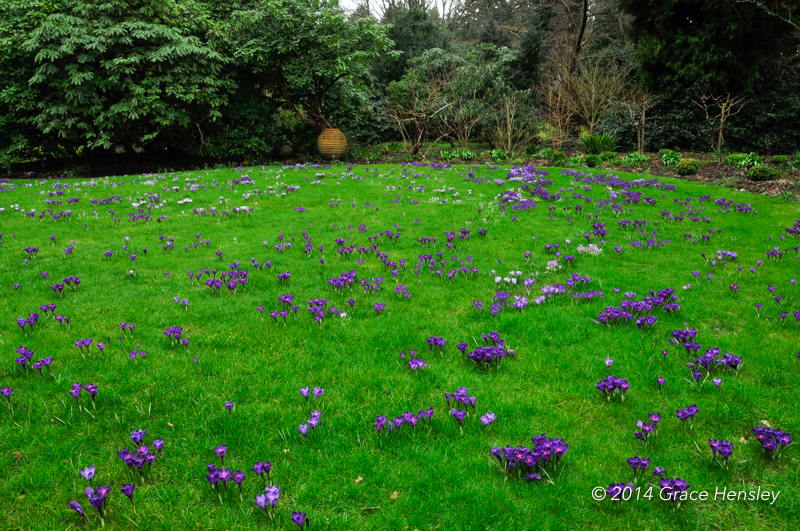
Withey and Price feed the lawn after flowering, to help the corms grow. Finally, don’t mow until a minimum of 6 weeks after the last flower fades. They will seed about and settle into the lawn … mowing with a collection bag will both reduce the vigor of the plant, and remove all of those seeds you want to keep! I can’t wait to collect my own seed this year to increase my own collection.
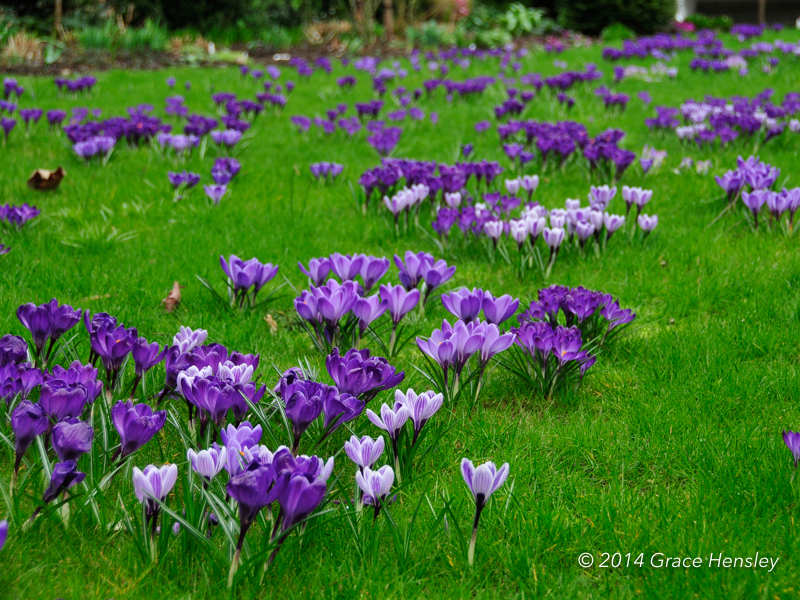
To do in July
Start drooling over catalogs and figure out your bulb order.
Picture This Photo Contest
It is with great trepidation that I submitted one of the crocus images to Saxon Holt’s resurrected Picture This Photo Contest, which you can find on the excellent blog Gardening Gone Wild with Fran Sorin and Debra Lee Baldwin. I particularly like their ecological low-water focus, and am grateful to Saxon’s desire to teach us how to see. See more of his work at Photo Botanic. I hope this encourages you all to enter the contests too.
Save
Save
Save

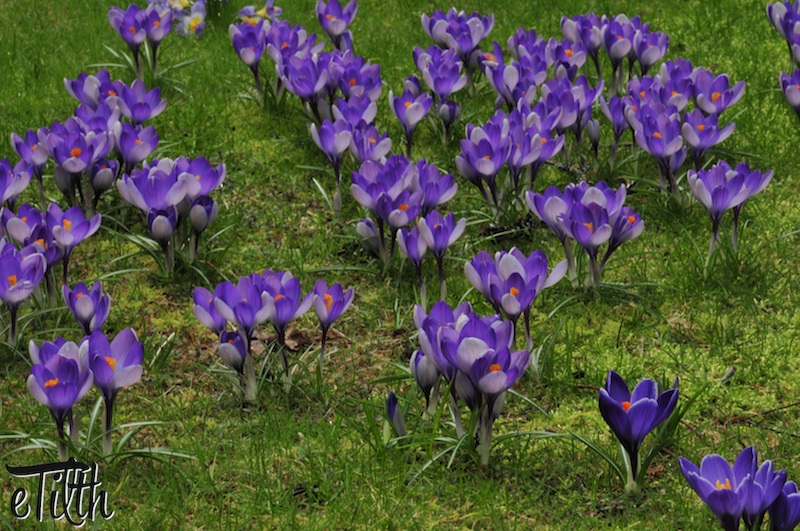



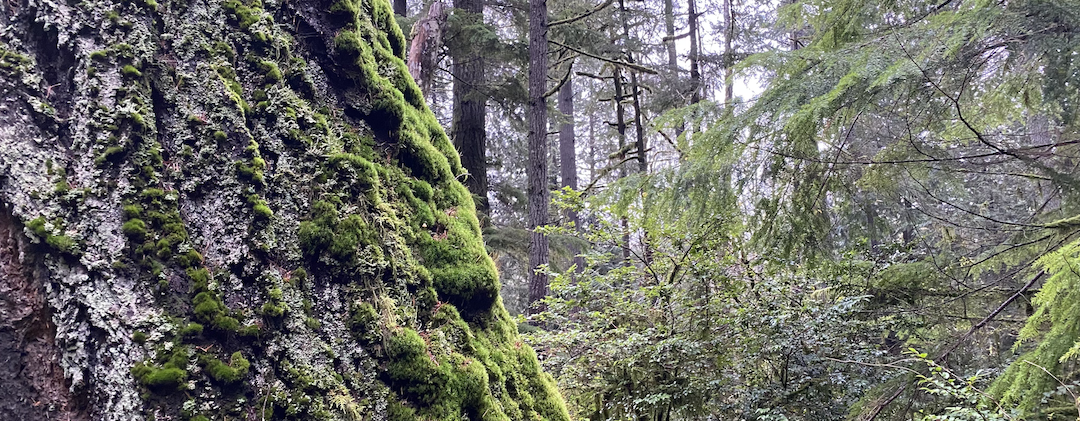

One Response
Five years ago, our first year living in the PNW, we rented a house in Broadview, right around the corner from the Dunn Gardens. That winter I went to the Crocus/Snowdrop Walk, and it was wonderful. Thanks for sharing your pictures! I’m fascinated by how they rolled up the lawn in concentric circles to plant.